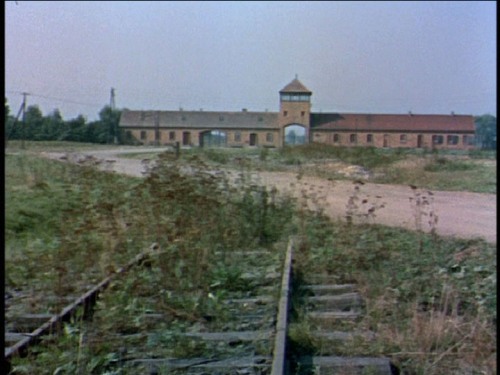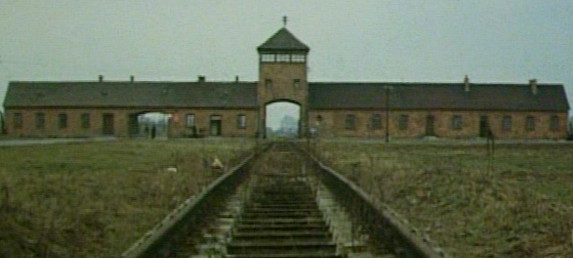Commissioned by Artforum‘s web site and published by them on December 8, 2010 in a somewhat different version. — J.R.
“The Holocaust is about six million people who get killed,” Stanley Kubrick reportedly said to screenwriter Frederic Raphael in the late 1990s. “Schindler’s List was about six hundred people who don’t.” One of the most striking things about this remark is its placement of the Holocaust in the present and a film made half a century later in the past.
These are the priorities of Claude Lanzmann’s Shoah (1985), 550 minutes long, widely and in some ways justly regarded as the greatest film about the Holocaust. But they’re also the priorities of Alain Resnais and Jean Cayrol’s Nuit et brouillard (Night and Fog, 1955), only thirty-one minutes long, which in many respects made Shoah possible. Shoah even quotes Night and Fog about forty-three minutes into the film — Resnais’s low-angle dolly following grassy railroad tracks that lead to an Auschwitz crematorium is virtually reprised and extended, though Resnais’ use of Eastmancolor is even more vivid.
One shouldn’t have to choose between these masterpieces. But it’s important to stress that they aren’t about precisely the same Holocaust and that their formal strategies for juxtaposing past and present are quite different. Night and Fog crosscuts between postwar remnants of the camps today in color and archival footage in black and white. Its Holocaust is pointedly not only Jewish (Jews in fact go unmentioned). Cayrol, a Resistance fighter sent to a camp in Mauthausen who later wrote a remarkable nouveau roman about the lies of the Occupation (Foreign Bodies, 1960) and Resnais’s Muriel (1963),notes in his offscreen text that “Nine million dead haunt this countryside.” (A more contemporary estimate might nearly double that figure.)
Shoah’s focus is more tribal. Polish antisemitism is highlighted, but the issue of two million Polish gentiles exterminated is clearly considered secondary. One could even argue that Shoah’s devastating impact and structure are predicated on a confrontational shotgun marriage between Lanzmann’s Judaism (signifying the past) and his existentialism (signifying the present) in which faces and voices recount remembered events while the camera lingers over locations where they once happened. The refusal of any archival footage or photographs gives a privileged status to the words of the interviewees, also lingered over by virtue of being subsequently translated — most often twice — from Polish or Hebrew or Yiddish to French, by Lanzmann’s interpreter, while the French is subtitled in English, meaning that we often discover what was said only during the interpreter’s translations.
The philosophical difference between these films is profound. Both address the impossibility of imagining the unimaginable while plying us with many facts and figures. But ultimately, despite its exhaustive length, Shoah registers as the more metaphysical work because of its more restricted view of the Holocaust victims. Most of these, of course, were Jewish, just as most people killed in the Twin Towers on 9/11 were American. But to reduce — or, worse, seek to elevate — either tragedy to ethnic or national proportions is ultimately to perpetuate the categories and definitions of the executioners.


